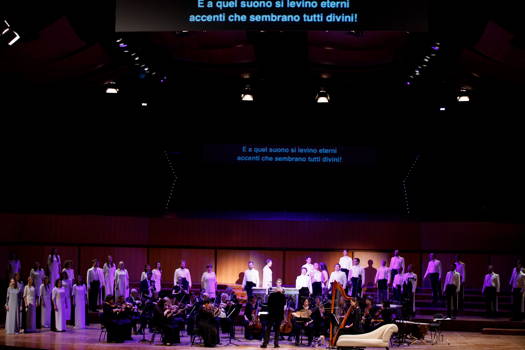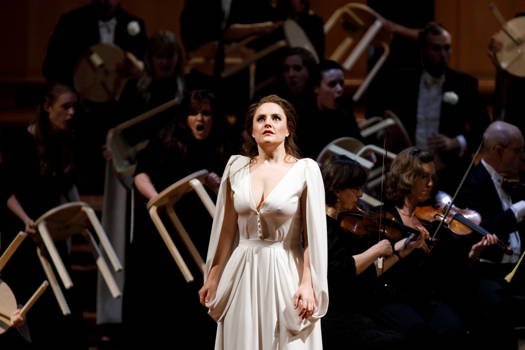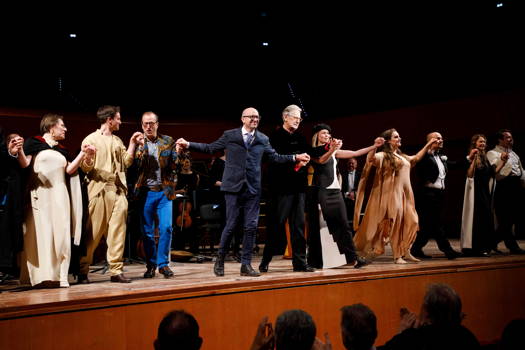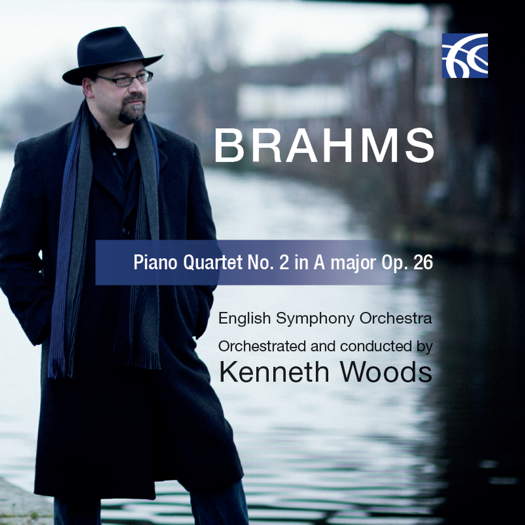- Cedille
- Steve Vasta
- Dunkirk
- Ramón Vinay
- Giordano Bruno
- Gabriele Bonolis
- Sam Cave
- Three Songs to poems by Edmund Waller
Heavenly Sex
GIUSEPPE PENNISI is impressed by Handel's 'Semele'
from John Eliot Gardiner and the Monteverdi ensembles
John Eliot Gardiner and his Monteverdi ensembles are on a European tour with Georg Fredrich Händel's Semele in a semi-staged production. The venues include the Philharmonie in Paris, Barcelona's Palau de la Música, Alexandra Palace Theatre in London, Milan's Teatro alla Scala, and Sala Santa Cecilia in Rome. I saw and heard the 8 May 2019 performance in Rome; it was a non-subscription performance. The tour venues are all large theatres: the smallest, London's Alexandra Palace, caters for an audience of about 1,300, and Sala Santa Cecilia some 3,000.

A scene from Handel's 'Semele'. Photo © 2019 Musacchio, Ianiello and Pasqualini
These theatres are not necessarily set for baroque opera. I remember performances of Semele in the Terrace Theatre in Washington D C, with five hundred seats, in the 1980s, and at the Teatro Caio Melisso in Spoleto, with four hundred seats, in 1996. They were a better fit for this intimate and sexy baroque opera. In Rome, there are other smaller halls - Sala Sinopoli and Sala Berio - within the Parco della Musica complex which also contains Sala Santa Cecilia. There are theatres perfect for baroque operas, such as Teatro di Villa Torlonia, described in Ulysses' Homecoming (Music & Vision, 9 October 2018), Teatro della Cometa and Teatro Argentina. Most likely, the choice of theatre depended on programming and scheduling considerations. However, a major promotional effort was made, including special discounts for subscribers to the National Santa Cecilia Academy concert series as well as to patrons of other significant musical institutions in Rome. The orchestra seats were almost full, but in the circle and upper tier, there were few listeners. In my opinion, the audience size was about 1,200 - a comparatively good turnout for an opera virtually unknown in Rome.
Semele is billed as an oratorio because there are ten choral numbers (as against three in most operas of that time). It is in reality an English-language opera, with a libretto by the Restoration playwright William Congreve, based on one of the more salacious passages of Ovid's Metamorphoses. Indeed the work's risqué storyline - 'Handel's sexiest opera', according to Gardiner - is one of the reasons why it was suppressed after only a few performances in Handel's lifetime. It's hard to conceive an oratorio - normally a sacred music piece - with so much sex in the plot. Several baroque operas are imbued with sex: think of Giovanni Cavalli's La Calisto, La Statira and Elena. In fact, in that period, only in the theatres (mostly functioning like private clubs) could sex be discussed. In Roman Catholic countries, the Inquisition forbade it, and in Protestant countries, the Boards of Censors were very prude. In Semele, the plot deals with the sexual relationship between the King of the Gods, Jupiter, and an attractive young princess, Semele. The action develops in the heavens. Thus, the subject of this bawdy opera is Heavenly Sex.
Despite the expressive arias and splendid choruses typical of oratorios, Handel's contemporaries initially turned up their noses at Semele's juicily erotic and ironic subject matter, which was considered inappropriate for an oratorio. After its debut in 1744, Semele fell into prolonged neglect until its first stage performances in modern times, in Cambridge, England, in 1925 and in London in 1954. These fueled an enthusiasm for the work that has not since lapsed. Semele was staged on four occasions - 1959, 1961, 1964 and 1975 - by the Handel Opera Society under Charles Farncombe. Then, it entered the repertory of Sadler's Wells Opera, now English National Opera, in 1970. The opera returned in 1982 - after a 238-year hiatus - to Covent Garden, the Royal Opera House, conducted, as at Sadler's Wells, by Charles Mackerras.
Today, Semele is one of Handel's most popular works worldwide. While his librettist William Congreve intended to show the inordinate influence of royal mistresses during the Restoration period, the director of this production, Thomas Guthrie, transports the court life of Handel's day to our own time, tracing an arc to the very recent British past with inventiveness, imagination and subtle humour. Thomas Guthrie's staging made great use of the space in the Sala Santa Cecilia. The Monteverdi Choir was not confined to serried ranks behind the orchestra, but bustled around the stage as eager guests at the wedding of Athamas to the reluctant Semele (who prefers Jupiter). There was a chaise longue for Semele to recline upon. It is an irresistibly charming work, full of galanterie and a sly eroticism belied by our wigged and portly image of Handel, and on this simple concert-platform. A winged messenger on a bicycle (Angala Hicjs) sings the aria 'Endless pleasure' on Semele's sexploits with Jupiter.
Semele has not been performed by John Eliot Gardiner and the Monteverdi ensembles since they recorded it in 1983 - a recording described by BBC Music Magazine as the 'best-conducted Semele on disc'. This 2019 tour's performances give audiences the chance to hear a fuller version of the work, notably with some passages by Handel very rarely heard in modern performances. Close examination of Handel's autograph (held in the British Library) and of some fragmentary sketches (held in the Fitzwilliam Museum in Cambridge) reveals the complex series of revisions made by Handel; it will be fascinating to explore some of these.
The star was Louise Adler as Semele, tremendously sung, sexily bending notes to suggest impure thoughts. In delivery of 'Oh, Sleep, why dost thou leave me?', she employed a tasty mezza voce and she and Lucile Richardot (as Ino) glided notes in their sisterly duet 'Prepare then, ye immortal choir'. She played 'Myself I shall adore' initially as self-mockery, but then fully succumbed to Juno's mirror. Her coloratura runs were exquisite, especially as she demands that Jupiter appear to her in godly form, which leads to her ultimate destruction.

Louise Adler in the title role of Handel's 'Semele'. Photo © 2019 Musacchio, Ianiello and Pasqualini
In the other women's roles, Lucile Richardot was both Juno and Ino; she is a superb actor and a very good mezzo, but the role of Juno is better sung by an alto, as shown by a 1973 recording where the part was entrusted to Marilyn Horne. Emily Owen was an effective Iris.
Hugo Hymas was a light Jupiter, but was very good in the difficult aria 'Where'er you walk'.
Most likely, Hymas and Carlo Vistoli (Athanas) had difficulties in coping with the enormous size of Sala Santa Cecilia. I heard Vistoli recently as Orfeo in Gluck's opera - read 'A Noble Simplicity', 18 March 2019 - and praised him as an excellent countertenor: in Semele his voice sounded pale, even though he sang with great purity. Gianluca Buratto's cavernous bass made a strong presence in the dual roles of Cadmus and Somnus.
The real marvel was the orchestra. There were all soloists playing period instruments. Gardiner extracted beautiful sonorities from the ensemble. The recitatives were simply enthralling.

The cast of Handel's 'Semele' at the end of the performance. Photo © 2019 Musacchio, Ianiello and Pasqualini
Semele is a long opera. It was nearly midnight when the audience erupted in ovation.
Copyright © 10 May 2019
Giuseppe Pennisi,
Rome, Italy





